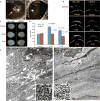Human limbal biopsy-derived stromal stem cells prevent corneal scarring
- PMID: 25504883
- PMCID: PMC4398334
- DOI: 10.1126/scitranslmed.3009644
Human limbal biopsy-derived stromal stem cells prevent corneal scarring
Abstract
Conventional allograft therapy for corneal scarring is widespread and successful, but donor tissue is not universally available, and some grafts fail owing to rejection and complications such as endothelial failure. We investigated direct treatment of corneal scarring using autologous stem cells, a therapy that, if successful, could reduce the need for corneal grafts. Mesenchymal cells were expanded from small superficial, clinically replicable limbal biopsies of human cadaveric corneo-scleral rims. Limbal biopsy-derived stromal cells (LBSCs) expanded rapidly in media containing human serum, were highly clonogenic, and could generate spheres expressing stem cell genes (ABCG2, Nestin, NGFR, Oct4, PAX6, and Sox2). Human LBSCs differentiated into keratocytes expressing characteristic marker genes (ALDH3A1, AQP1, KERA, and PTGDS) and organized a thick lamellar stroma-like tissue containing aligned collagen and keratan sulfate proteoglycans when cultured on aligned nanofiber substrata. When engrafted into mouse corneal wounds, LBSCs prevented formation of light-scattering scar tissue containing fibrotic matrix components. The presence of LBSCs induced regeneration of ablated stroma with tissue exhibiting lamellar structure and collagen organization indistinguishable from that of native tissue. Because the limbus can be easily biopsied from either eye of an affected individual and LBSCs capable of corneal stromal remodeling can be expanded under xeno-free autologous conditions, these cells present a potential for autologous stem cell-based treatment of corneal stromal blindness.
Copyright © 2014, American Association for the Advancement of Science.
Conflict of interest statement
Figures







Similar articles
-
Easy xeno-free and feeder-free method for isolating and growing limbal stromal and epithelial stem cells of the human cornea.PLoS One. 2017 Nov 17;12(11):e0188398. doi: 10.1371/journal.pone.0188398. eCollection 2017. PLoS One. 2017. PMID: 29149196 Free PMC article.
-
Reconstruction of a human hemicornea through natural scaffolds compatible with the growth of corneal epithelial stem cells and stromal keratocytes.Mol Vis. 2009 Oct 17;15:2084-93. Mol Vis. 2009. PMID: 19862337 Free PMC article.
-
A role for topographic cues in the organization of collagenous matrix by corneal fibroblasts and stem cells.PLoS One. 2014 Jan 21;9(1):e86260. doi: 10.1371/journal.pone.0086260. eCollection 2014. PLoS One. 2014. PMID: 24465995 Free PMC article.
-
Characterization, isolation, expansion and clinical therapy of human corneal epithelial stem/progenitor cells.J Stem Cells. 2014;9(2):79-91. J Stem Cells. 2014. PMID: 25158157 Review.
-
[Transplantation of corneal endothelial cells].Nippon Ganka Gakkai Zasshi. 2002 Dec;106(12):805-35; discussion 836. Nippon Ganka Gakkai Zasshi. 2002. PMID: 12610838 Review. Japanese.
Cited by
-
Modeling the cornea in 3-dimensions: Current and future perspectives.Exp Eye Res. 2020 Aug;197:108127. doi: 10.1016/j.exer.2020.108127. Epub 2020 Jun 30. Exp Eye Res. 2020. PMID: 32619578 Free PMC article. Review.
-
Reversed Corneal Fibroblasts Therapy Restores Transparency of Mouse Cornea after Injury.Int J Mol Sci. 2024 Jun 27;25(13):7053. doi: 10.3390/ijms25137053. Int J Mol Sci. 2024. PMID: 39000162 Free PMC article.
-
Cell-Free Biological Approach for Corneal Stromal Wound Healing.Front Pharmacol. 2021 May 28;12:671405. doi: 10.3389/fphar.2021.671405. eCollection 2021. Front Pharmacol. 2021. PMID: 34122095 Free PMC article. Review.
-
In Situ-Forming Collagen-Hyaluronate Semi-Interpenetrating Network Hydrogel Enhances Corneal Defect Repair.Transl Vis Sci Technol. 2022 Oct 3;11(10):22. doi: 10.1167/tvst.11.10.22. Transl Vis Sci Technol. 2022. PMID: 36239965 Free PMC article.
-
Assembly and Application of a Three-Dimensional Human Corneal Tissue Model.Curr Protoc Toxicol. 2019 Sep;81(1):e84. doi: 10.1002/cptx.84. Curr Protoc Toxicol. 2019. PMID: 31529796 Free PMC article.
References
-
- Jester JV, Barry-Lane PA, Cavanagh HD, Petroll WM. Induction of α-smooth muscle actin expression and myofibroblast transformation in cultured corneal keratocytes. Cornea. 1996;15:505–516. - PubMed
-
- Koh S, Maeda N, Nakagawa T, Nishida K. Quality of vision in eyes after selective lamellar keratoplasty. Cornea. 2012;31(Suppl. 1):S45–S49. - PubMed
-
- Patel SV, McLaren JW, Hodge DO, Baratz KH. Scattered light and visual function in a randomized trial of deep lamellar endothelial keratoplasty and penetrating keratoplasty. Am J Ophthalmol. 2008;145:97–105. - PubMed
-
- Pascolini D, Mariotti SP, Pokharel GP, Pararajasegaram R, Etya’ale D, Négrel AD, Resnikoff S. 2002 global update of available data on visual impairment: A compilation of population-based prevalence studies. Ophthalmic Epidemiol. 2004;11:67–115. - PubMed
Publication types
MeSH terms
Substances
Grants and funding
LinkOut - more resources
Full Text Sources
Other Literature Sources
Medical
Miscellaneous

